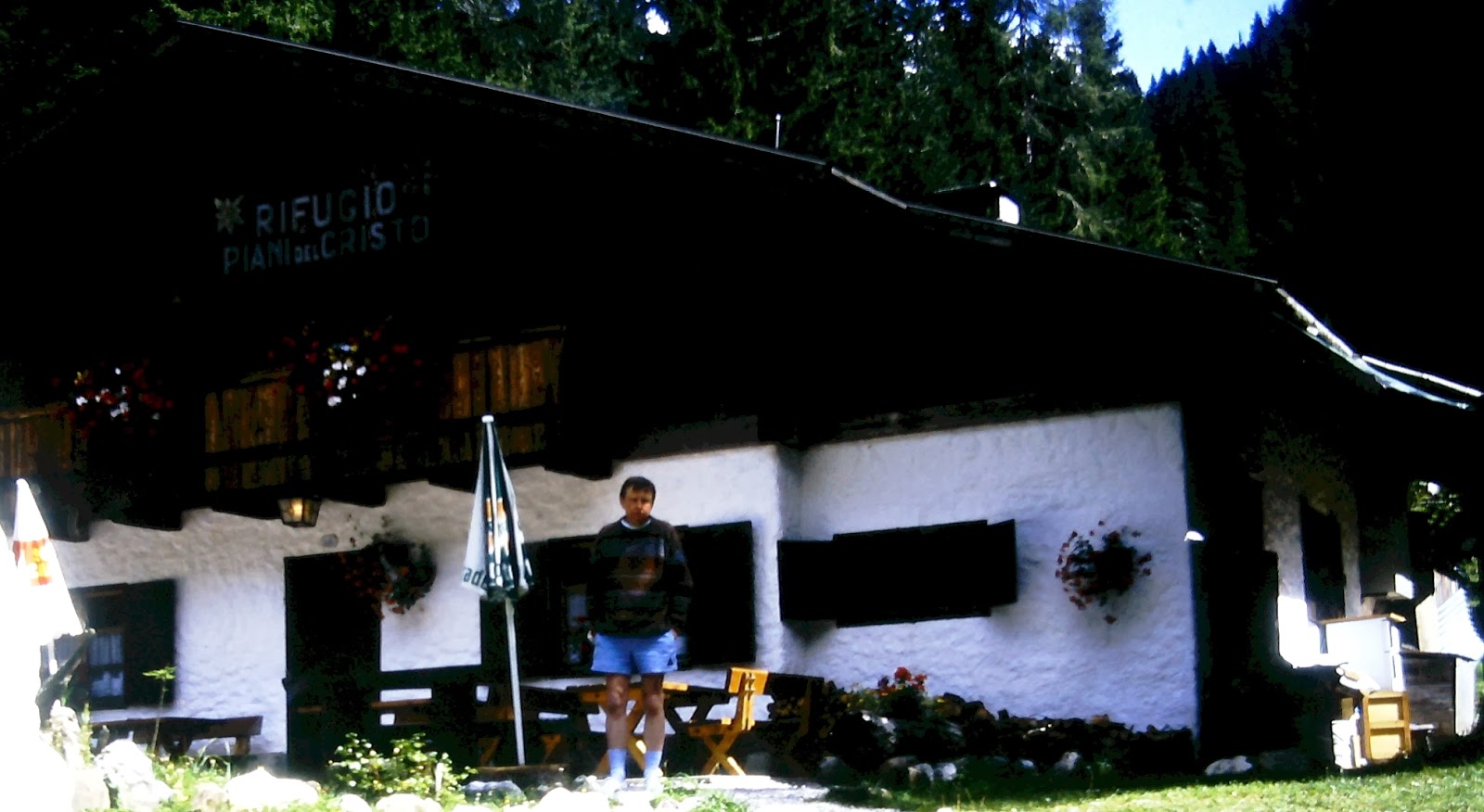The source of the Piave lies high up in the Dolomites on the slopes of Monte Peralba, above the alpine village of Cima Sappada. Cima Sappada is marked on the map of Ethnographical Itineraries in Veneto Itinerary 1 as 'Sappada'. There are several tributaries of the Piave marked on the map as the 'sorgenti del Piave', but one in particular on Monte Peralba is regarded as the 'true source' by the Italian people. The Piave River is important in the history of Italy, as it was where the Italian forces stood firm against the Austro-Hungarian armies in WW1, the waters of the river 'running red with blood'. The momentous events of that time are remembered in stirring songs, still sung to this day.
In 1998 I flew to Milan and thence by train and bus to Cima Sappada, basing myself and my folding bicycle Una at the truly wonderful and hospitable Hotel Belvedere.
 |
| A souvenir from a stay in Cima Sappada in 1998 |
The view of Cima Sappada from my room at the hotel was stunning. The village is surrounded by the Dolomite peaks on all sides, with the mist constantly drifting through them.
The next morning Una (full name Una Bicicletta) and I set off on the long ascent of the road that rises out of the valley following the Piave to the source. You can tell from the photo (above) that the way we took was steep.
The morning sun burning off the mountain mists
© Peter Alexander Gray 1998
|
The Dolomite Mountains (originally called the Eastern Alps) dwarf everything in the field of view.
Once a coral reef, the rock is soft and there are many landslips. The mineral composition was discovered by a French geologist - Dieudonné Sylvain Guy Tancrède de Gratet de Dolomieu. (His mum just called him Dieu for short.)
On journeys through Italy you will find many tiny shrines by the roadside, or on the banks of streams and rivers. There is such a shrine to be found on the ascent of Monte Peralba, on the bank of the stream that is the source of the river.
 |
| Shrine seen in the dappled light shining through the trees
© Peter Alexander Gray 1998
|
 |
| Offerings to Santa Maria di Luggau © Peter Alexander Gray 1998 |
Behind bars, inside, are flowers and other offerings to Santa Maria di Luggau.
Each year since 1804, in the third Saturday of September, the people of the locality gather before dawn at Cima Sappada to make a pilgrimage.
They ascend the road to the source of the Piave and then head over the border, to the Austrian town of Luggau and the Santuario di Santa Maria.
There they give thanks to the Holy Mother (whom they believe, in centuries past, spared the region from the plague) before returning to Cima Sappada for a mass the next day.
 |
| Maintained with true devotion... © Peter Alexander Gray 1998 |
 |
| From Cima Sappada to the refuge on the Piani del Cristo Carte e Piante Turistiche Tobacco sheet 1 |
Fortunately,there is the Rifugio Piani del Cristo (circled) en route that allows for exhausted cyclists to collapse and take in food and liquids of all types.
 |
| Cyclist burning out (me) © Peter Alexander Gray 1998 |
They have, arrayed above the bar, a whole range of bottles of grappa. After eating a hearty lunch I tried one infused with lemon and basil. Magnificent... the only word I could find...
 |
| Lady behind the bar watching anxiously as grappa accesses the parts beyond the reach of Heineken |
© Peter Alexander Gray 1998
Somehow, setting off again, the mountain seemed a lot steeper. And there was a long, long way to go...
 |
| The hard slog, onwards and up, to the end of the road... Carte e Piante Turistiche Tobacco sheet 1 |
About a mile from the end of the road I came across an estate car pulled into a makeshift lay-by on one side, the owner snapping away with his camera. A polite enquiry (along with a pleading look designed to convey total exhaustion) as to whether it was much further to the source of the Piave immediately persuaded the good man to open up the rear of his vehicle and in a matter of moments Una was stowed safely inside.
Collapsing into the passenger seat I realised fully for the first time why man had felt the need to invent the motor car.
 |
| The Source of the Piave © Peter Alexander Gray 1998 |
 |
| The church at the source of the Piave © Peter Alexander Gray 1998 |
Not far from the monument is a tiny church. Despite the size, inside it is a treasure trove.
 |
| Madonna and Child above the altar © Peter Alexander Gray 1998 |
 |
| High up on one wall, Psalm 103 © Peter Alexander Gray 1998 |
But it was time for my departure, to set off from here to follow the Piave on the river's long, eventful journey to Venice and the Adriatic. Here, in the Dolomite mountains, is where the journey starts.
Note: This blog supports readers of The Door of Perarolo, a historical novel set in Cadore, Italy in the early nineteenth century. You may examine feedback from readers in the UK here and in the US here. The Door of Perarolo is a Kindle ebook comprising 140 chapters. It can be downloaded from Amazon sites worldwide. The launch post of this blog gives further details. The second post provides links to maps, etc.


No comments:
Post a Comment